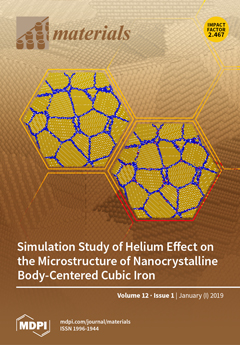Three typical surface pretreatment strategies (grind, drawing, polishing) are employed to explore the influence of alloy substrate treatment on microstructure and surface performances of arc-ion plated TiN and ZrN films. The luminance and color of the films are measured by the color coordinate
[...] Read more.
Three typical surface pretreatment strategies (grind, drawing, polishing) are employed to explore the influence of alloy substrate treatment on microstructure and surface performances of arc-ion plated TiN and ZrN films. The luminance and color of the films are measured by the color coordinate value of CIELab system (a color system which is defined by the International Commission on illumination). The crystal phases, morphology and microstructure are characterized and analyzed by scanning electron microscope (SEM) and X-ray powder diffraction (XRD). In addition, the anti-alkali, salt corrosion and anti-oxidation performances of films are systematically researched. The results show that the films with grinding pretreatment are more like gold color, “L” values are 77.27 cd/m
2 and 80.30 cd/m
2. The “b” value of TiN film is 29.96, which is the same as that of pure gold. The “a” value of ZrN film is 0.31, which is the same as pure silver. The density of TiN and ZrN films is the best, and both TiN and ZrN films were crystalline. They have the best anti-alkali and anti-oxidation performance. The films with drawing pretreatment show slant red color and have medium brightness values (74.07–76.37 cd/m
2), worse compactness, obvious furrows and holes in their microstructures and worse salt corrosion and anti-oxidation performances. However, the TiN films are in amorphous states. The films with polishing pretreatment have the lowest brightness (72.66 cd/m
2), gold-like color, superior compactness and best salt corrosion performance, which have a small number of holes. The TiN films with polishing pretreatment are also in amorphous state. Above all, alloy substrate pretreatment by grinding has the best gold-like color, brightness, compactness and corrosion resistance performance. This work exclusively sheds new light on surface pretreatment of alloy substrate by arc-ion plated films and also provides a reference for corrosion resistance performance of gold-like films.
Full article






